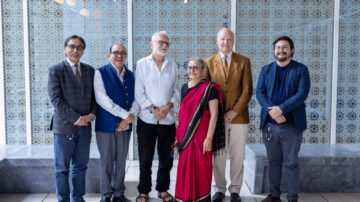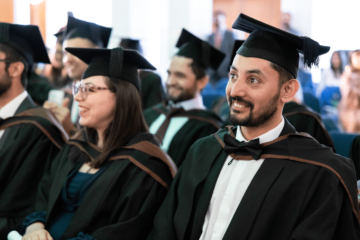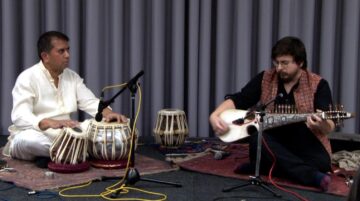Mr Daniel Beben of Indiana University, USA, and Mr Matthew Melvin-Koushki of Oxford Universtiy, UK, were the first two speakers in the IIS’ 2013 Lecture Series.
Mr Daniel Beben of Indiana University, USA, delivered a lecture at the IIS on 15th January, entitled Jami‘ al-salasil and the Place of Nasir-i Khusraw in the Central Asian Sufi Tradition. Mr Beben is a PhD Candidate at Indiana University and is currently conducting research on the Ismaili tradition of Central Asia from the fifteenth to nineteenth centuries.
The focus of this lecture was Nasir-i Khusraw, a renowned poet, philosopher, and Ismaili missionary of the eleventh century. Among his many accomplishments, he is credited for having introduced the people of the mountainous Central Asian province of Badakhshan to the Ismaili Muslim tradition and is still widely revered among the Ismaili communities of Central Asia. However, there is also another aspect to the legacy of Nasir-i Khusraw in Central Asia which has not been as widely recognised, namely his reputation as a Sufi saint among many Sunni communities in Badakhshan and surrounding areas.
This aspect of Nasir-i Khusraw’s legacy is documented in a number of texts dating from the fifteenth to the nineteenth centuries, which are often accompanied by a pseudo-autobiography of Nasir-i Khusraw. This fabricated autobiography seeks to re-write the history of Nasir-i Khusraw, presenting him as a Sunni Muslim with no affiliation to the IsmailisAdherents of a branch of Shi’i Islam that considers Ismail, the eldest son of the Shi’i Imam Jaʿfar al-Ṣādiq (d. 765), as his successor..
In his talk, Mr Beben surveyed a body of hagiographical literature produced between the 14th and 19th centuries which reflect the acceptance and establishment of Nasir-i Khusraw within the Sufi traditions of Central Asia. He focussed particularly on an account found in a previously unstudied source: the Jami‘ al-salasil of Majd al-Din ‘Ali Badakhshani.
According to Mr Beben, the Jami‘ al-salasil is a hagiographical summary written in 1640 in India by the grandson of a well-known Shaykh of the Kubravi Sufi order from Badakhshan. The text explores the major Sufi communities of India and Central Asia, looking particularly at the local mystical traditions of Badakhshan and asserting the prominence of this region within the spiritual geography of the eastern Muslim world. Badakhshani’s account of Nasir-i Khusraw in this text offers a unique window into the appropriation of this figure within the narrative traditions of the Central Asian Sufi orders.
“The importance of this textual tradition is not found in what it may tell us about the historical biography of Nasir-i Khusraw, but rather in what it may tell us about the histories of the communities in which it developed and circulated. It reveals to us a rich pattern of interactions between Ismaili and non-Ismaili communities in Central Asia, centred on the personage and sanctity of Nasir-i Khusraw, and demonstrates how the legacy of this figure became a means for the people of Badakhshan to assert their place within the broader currents of Muslim civilization”, says Mr Beben.
Daniel Beben also examined a number of ‘counter-narratives’ found in Ismaili texts and in the records of Russian ethnographic accounts of Ismaili communities from the early twentieth century, which demonstrate an effort to place the Ismaili da‘wa once again at the centre of Central Asia’s religious history. Mr Beben argued that these accounts demonstrate that the Ismaili tradition of Central Asia, far from being a marginal phenomenon in the region, was in fact closely engaged with the broader spiritual debates of Muslim society in Central Asia.
Mr Melvin–Koushki’s lecture on Occultism, Science and Empire in the Early Modern Islamic World, which took place on 26 February, discussed his initial research into Letterism as a scientific endeavour in the early modern Muslim world. In his lecture, Mr Melvin-Koushki made a case for further study into how occultism had an impact on the construction of the early modern empire and the development of experimental natural philosophy. He argued that, in order to properly evaluate the great florescence of occultist discourses in the Islamic world from the 13th Century onwards, a fundamental re-periodisation of later history is required.
Mr Melvin-Koushki said, “We need to re-look at texts and history of the early modern Islamic world while recognising the emergence of walaya, or sanctified power, as a hegemonic concept in Islamic cultures, which drove intellectual, social, religious, political, economic and creative developments, often associated with the advent of modernity. In other words, by the early modern period, sainthood was adopted as a fundamental basis for a wide range of cultural narratives from theories of kingship to occult science”.
To see Daniel Beben talk about his research view this video:






